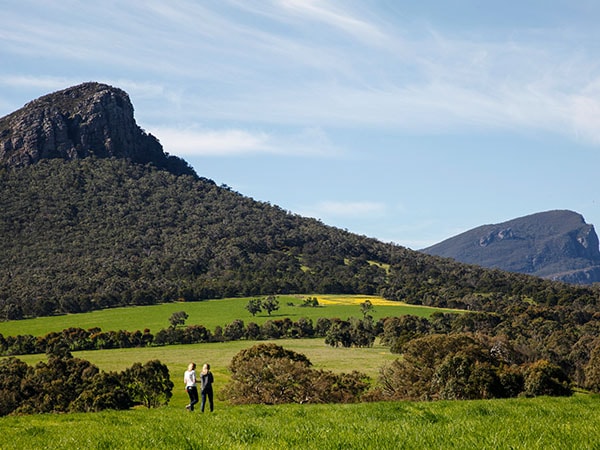June 03, 2022
![]() 6 mins Read
6 mins Read
A crescent of sand lapped by foamy whitewater and backed by steep, shrub-cloaked cliffs, this dazzling Great Ocean Road beach resembles a natural amphitheatre. The world’s first Surfing Recreation Reserve, Bells Beach is, of course, popular with seasoned surfers, who come to tackle the heavy swells that peak come winter. But it’s also frequented by paragliders and day trippers who come to see if this iconic stretch of Aussie coastline is as dramatically beautiful as the photos suggest (spoiler alert: it is). Drink it all in from the top of the timber staircase that leads down to the golden sand before walking the length of the shoreline, the salty spray from the surf misting around you.

The iconic Bells Beach resembles a natural amphitheatre. (Image: Visit Victoria)
A little known yet rewarding find, this scenic lake hidden deep in the Great Otway National Park is as atmospheric and eerily beautiful as they come. Lake Elizabeth’s defining feature is its tree trunk-dotted waters; when the valley was flooded more than 50 years ago the trees drowned, but their trunks still stand.

This scenic lake hidden deep in the Great Otway National Park is as atmospheric and eerily beautiful as they come. (Image: Visit Victoria)
Spend the night in the Lake Elizabeth campground – a small, scenic clearing that’s sheltered by lofty eucalypts and thick vegetation – and you’ll see this perched lake in all its glory. Sit on the lake’s banks as dawn breaks and the morning mist begins to lift, or stop by at dusk when the elusive platypus comes out to play (you may even spot some glow worms, too).

Sit on the lake’s banks as dawn breaks and the morning mist begins to lift. (Image: Visit Victoria)
The impossibly green landscapes of this national park conceal a multitude of treasures. Stretching from the verdant hilly hinterland all the way to the Great Ocean Road’s rugged and briny shores, the park covers a whopping 100,000-plus hectares. Within the borders of the Great Otway National Park you can expect to uncover a wealth of natural features: half a dozen waterfalls occupy the park’s cool temperate rainforest, walking trails snake through gullies drenched with ferns, windswept heathlands come alive with wildflowers in spring, and deserted beaches unsullied by humans are struck by thunderous waves.

The impossibly green landscapes and pretty waterfalls of the Great Otway National Park. (Image: Visit Victoria)
Port Campbell National Park is home to two headline attractions that have become synonymous with the Great Ocean Road itself: the 12 Apostles and Loch Ard Gorge. While just seven sea stacks remain, the so-called 12 Apostles are still quite a sight to behold as the imposing limestone rock forms tower out of the ocean, framed by aquamarine waters and a ribbon of sand.

Nothing will ever prepare you for your first sighting of the 12 Apostles. (Image: Visit Victoria)
Loch Ard Gorge is another non-negotiable. Walk down to the beach, lapped by calm waters and flanked by yellowing cliff faces, and relish feeling exceptionally small next to the majestic sandstone walls.

Relish feeling exceptionally small next to the majestic sandstone walls of Loch Ard Gorge. (Image: Great Ocean Road Tourism)
Once a volcanic island, the lengthy coastline of Cape Bridgewater is home to a clutch of curious natural attractions. Within its boundaries lie two parks (Mount Richmond National Park and Discovery Bay Coastal Park, both important habitats for a wealth of birdlife), as well as a sizable colony of Australian fur seals, a large blowhole, a series of limestone caves, huge sand dunes and an otherworldly ‘petrified forest’, which is actually a collection of hollow tubes of limestone that resemble termite mounds. But the piece de resistance at this westerly headland are the sea cliffs. Stony Hill, the highest cliff top in Victoria, rises some 130 metres above sea level and makes a plum spot for observing southern right whales in winter and spring.

Cape Bridgewater is home to a clutch of curious natural attractions. (Image: Visit Victoria)
This UNESCO World Heritage-listed site is the only one in the country to be recognised exclusively for its cultural significance. Budj Bim National Park‘s volcanic terrain and landscapes, deftly and sensitively manipulated by the Gunditjmara people some 6600 years ago, are a sight to behold. Marvel at the complex network of channels, dams and weirs forged from floodplains to trap and harvest kooyong (eels) in one of the oldest and largest aquaculture systems on the planet.

This UNESCO World Heritage-listed site is the only one in the country to be recognised exclusively for its cultural significance. (Image: Great Ocean Road Tourism; Lauren Doolan)
Whether you’re admiring the 360-degree views of the surrounding ranges and volcanic plains from atop its craggy peak, or gazing up at the knobbly summit of this 550-metre-tall mountain from below, Mt Sturgeon is a striking landmark that commands attention. It’s a rather strenuous grade four hike to the top, through open woodland, past exposed ledges and over water crossings. Expect to spend roughly three hours completing the six-kilometre hike.

Mt Sturgeon is a striking landmark that commands attention. (Image: Visit Victoria)
Adventuring through the Greater Hamilton region? Make a pitstop at the crest of this extinct volcano for stellar views over the pancake-flat green and gold patchwork of farmland below. Located on the third largest volcanic plain on Earth, known as the Kanawinka region by the land’s traditional custodians, there’s a crater lake to view and plenty of wildlife to chance upon; think echidnas, kangaroos, wallabies, possums and peregrine falcons.

Make a pitstop at the crest of this extinct volcano for stellar views over the pancake-flat green and gold patchwork of farmland below. (Image: Great Ocean Road Tourism; Belinda Van Zanen)
For the  best travel inspiration delivered straight to your door.
best travel inspiration delivered straight to your door.
LEAVE YOUR COMMENT